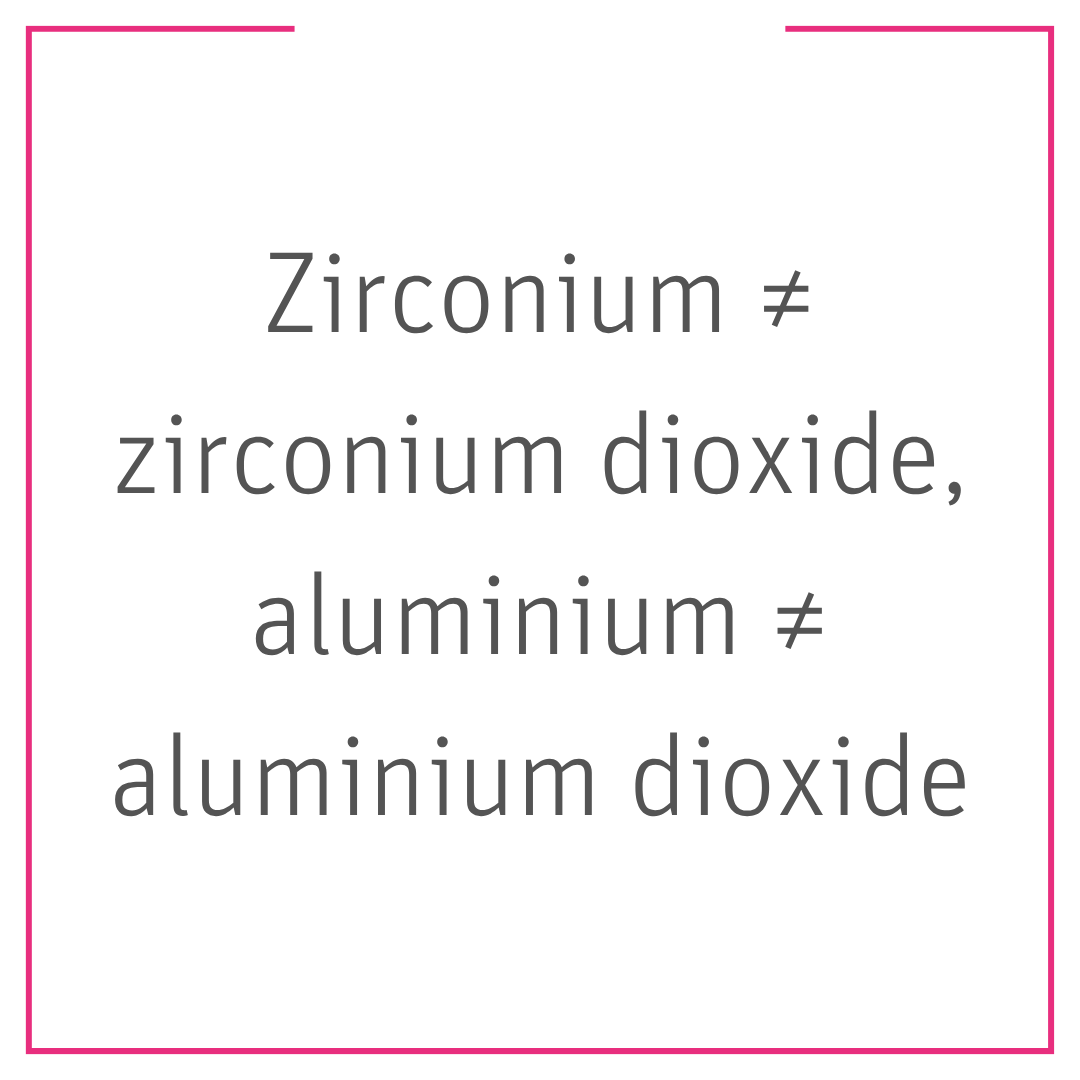Zirconium vs. zirconium dioxide, aluminium vs. aluminium dioxide: what is the difference between metal and ceramic?

> Is zirconium dioxide (zirconia) a metal?
> What are the properties of zirconium dioxide?
> Is aluminium dioxide a metal?
> What role does aluminium dioxide play in the manufacture of dental implants?
Is zirconium dioxide (zirconia) a metal?
Zirconium dioxide (ZrO₂) is not a metal, but an oxide of the metal zirconium (Zr) (Greenwood & Earnshaw 1997) and belongs to the group of oxide ceramics. Oxides do not have the typical properties of metals such as electrical conductivity or malleability (Elsner 2019; Schatt 2015). None of these properties are present in zirconium dioxide. Instead, zirconium dioxide has insulating and high-temperature-resistant properties (Müller, 2016).
Pure zirconium dioxide usually occurs in powder form and, for better material stability and higher flexural strength, is processed into blanks by adding aluminium oxide and yttrium oxide for hot isostatic pressing (HIP), from which Zeramex XT implants and abutments are manufactured using a hard machining process.
Pure zirconium (chemical symbol: Zr, atomic number: 40), on the other hand, is a silvery-shiny transition metal that is located in the 5th period and 4th group (titanium group) of the periodic table.
What are the properties of zirconium dioxide?
The important properties of zirconium dioxide:
- Zirconium dioxide occurs in various modifications or allotropes or phases: monoclinic, tetragonal or cubic (Greenwood & Earnshaw 1997)
- Zirconium dioxide has a high Mohs hardness of about 8-8.5 (Müller 2016)
- Zirconium dioxide has high heat resistance (its melting point is around 715 °C (Greenwood & Earnshaw 1997)
- Zirconium dioxide is often used as a high-performance ceramic in medical technology/implantology, e.g. as a composite material of ATZ & TZP-A for implants and implant restorations
Is aluminium dioxide a metal?
Aluminium dioxide (Al₂O₃) is not a metal, but a chemical compound of aluminium and oxygen. It belongs to the class of oxides and exhibits typical properties of ceramics, such as high hardness and chemical stability (Callister & Rethwisch 2020). The metal aluminium, on the other hand, is characterised by metallic bonds and properties such as electrical conductivity, ductility and metallic lustre. Aluminium dioxide, however, is solid and electrically insulating, which distinguishes it from the metal aluminium (Greenwood & Earnshaw 1997).
What role does aluminium dioxide play in the manufacture of dental implants?
Aluminium dioxide or alumina is used in medical technology, for example in the form of alumina-toughened zirconia (ATZ), to improve the mechanical properties of dental implants. Studies show that such composite materials exhibit increased resistance to ageing processes, making them suitable for biomedical applications (Deville et al., 2018).
References
Callister, W. D., & Rethwisch, D. G. (2020). Materials Science and Engineering: An Introduction (10th ed.). Wiley.
Deville, S., Chevalier, J., Fantozzi, G., Bartolomé, J., Requena, J., Moya, J., Torrecillas, R., & Diaz, L. A. (2018). Low-temperature ageing of zirconia-toughened alumina ceramics and its implication in biomedical implants. arXiv preprint arXiv:1803.10465. Abgerufen von arxiv.org.
Elsner, A. (2019). Werkstoffe der Elektrotechnik: Grundlagen – Eigenschaften – Anwendungen (6. Auflage). Springer Vieweg. DOI: 10.1007/978-3-662-57846-9
Greenwood, N.N., & Earnshaw, A. (1997). "Chemistry of the Elements" (2nd ed.)
Müller, W. (2016). "Technische Keramik: Werkstoffe, Verfahren, Anwendungen".
Schatt, W. (2015). Werkstoffwissenschaft: Struktur und Eigenschaften von Metallen, Keramiken, Polymeren und Verbundwerkstoffen. Springer Vieweg. DOI: 10.1007/978-3-662-57763-9
Didn't find the answer to your question?
Leave a comment
Comments
No comments have been posted yet.


